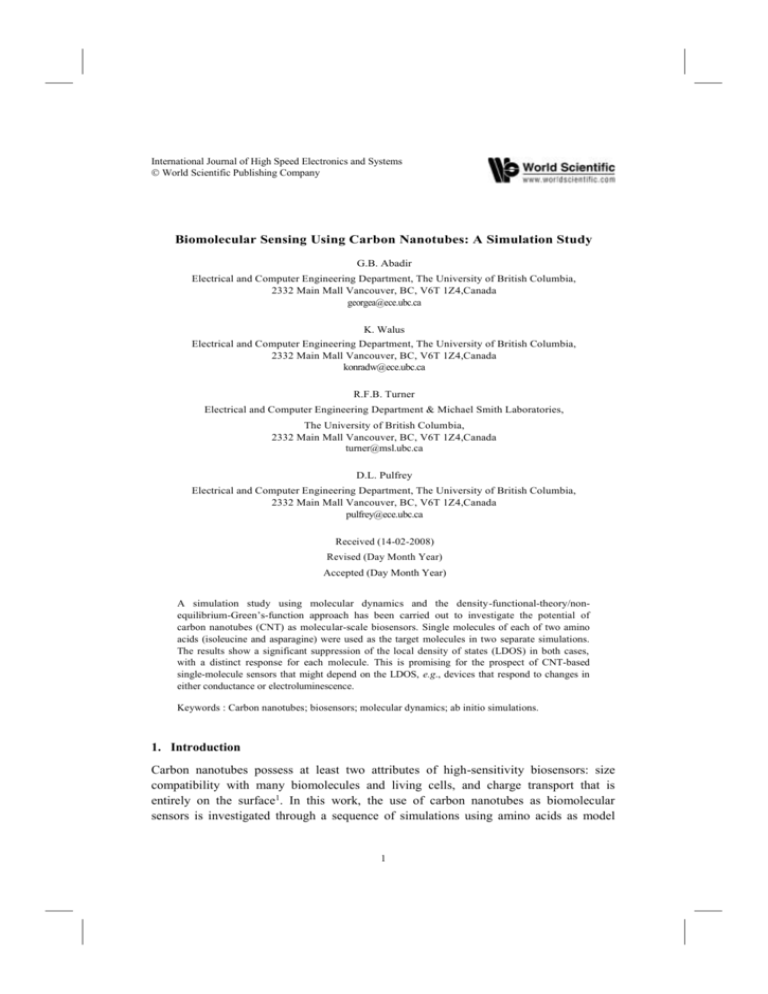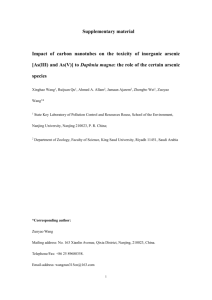G.B. Abadir, K. Walus, R.F.B. Turner, and D.L. Pulfrey
advertisement

International Journal of High Speed Electronics and Systems World Scientific Publishing Company Biomolecular Sensing Using Carbon Nanotubes: A Simulation Study G.B. Abadir Electrical and Computer Engineering Department, The University of British Columbia, 2332 Main Mall Vancouver, BC, V6T 1Z4,Canada georgea@ece.ubc.ca K. Walus Electrical and Computer Engineering Department, The University of British Columbia, 2332 Main Mall Vancouver, BC, V6T 1Z4,Canada konradw@ece.ubc.ca R.F.B. Turner Electrical and Computer Engineering Department & Michael Smith Laboratories, The University of British Columbia, 2332 Main Mall Vancouver, BC, V6T 1Z4,Canada turner@msl.ubc.ca D.L. Pulfrey Electrical and Computer Engineering Department, The University of British Columbia, 2332 Main Mall Vancouver, BC, V6T 1Z4,Canada pulfrey@ece.ubc.ca Received (14-02-2008) Revised (Day Month Year) Accepted (Day Month Year) A simulation study using molecular dynamics and the density-functional-theory/nonequilibrium-Green’s-function approach has been carried out to investigate the potential of carbon nanotubes (CNT) as molecular-scale biosensors. Single molecules of each of two amino acids (isoleucine and asparagine) were used as the target molecules in two separate simulations. The results show a significant suppression of the local density of states (LDOS) in both cases, with a distinct response for each molecule. This is promising for the prospect of CNT-based single-molecule sensors that might depend on the LDOS, e.g., devices that respond to changes in either conductance or electroluminescence. Keywords : Carbon nanotubes; biosensors; molecular dynamics; ab initio simulations. 1. Introduction Carbon nanotubes possess at least two attributes of high-sensitivity biosensors: size compatibility with many biomolecules and living cells, and charge transport that is entirely on the surface1. In this work, the use of carbon nanotubes as biomolecular sensors is investigated through a sequence of simulations using amino acids as model 1 2 G.B. Abadir, K. Walus, R.F.B. Turner, and D.L. Pulfrey analytes. First, molecular dynamics (MD) simulations are performed with two objectives in mind: (i) to investigate the effects of hydrophobic interactions and van der Waals (VDW) forces on the adsorption of amino acids by carbon nanotubes; (ii) to determine the relative coordinates of the molecules and the nanotube. These coordinates are then incorporated in density-functional-theory/non-equilibrium-Green’s-function (DFT/NEGF) simulations, the aim of which is to investigate the changes that amino-acid adsorption induces in the local density of states (LDOS) of the carbon nanotube. 2. Simulation Flow and Results 2.1 Molecular Dynamics simulations MD simulations for carbon nanotubes with amino acids have been carried out using GROMACS2. Both large-diameter tubes (chirality of (12,11)) and small-diameter tubes (chirality of (10,0)) were used, with the tubes’ length being 8 nm in all cases. The amino acids isoleucine (ILE) (which has a strongly hydrophobic neutral side-chain), and asparagine (ASN) (which has a strongly hydrophilic neutral side-chain), were investigated in separate simulations. In each case, forty dimers of the relevant amino acid were positioned along the length of the tube at a radial distance of 1nm from the surface of the tube. Each dimer consisted of two residues, where the residue is the form taken by amino acids when they constitute a chain of peptides, or comprise parts of proteins3. As an example, the initial positions of the ASN dimers around a (12,11) tube are shown in Fig. 1. Fig. 1. Initial configuration of ASN dimers surrounding a (12,11) CNT at a radial distance of 1 nm from the CNT surface. The water molecules in which the dimers and CNT are immersed are omitted for clarity. Sensing Biomolecules Using Carbon Nanotubes: A Simulation Study 3 A reaction duration of 6 ns was simulated, under conditions of constant pressure (1 atm) and temperature (300 K) using Parrinello-Rahman4- and Berendsen5- coupling, respectively. The simulation was performed in an aqueous medium. The AMBER99 force field port6 in GROMACS was used, and the TIP3P water model7 was implemented. The Lennard-Jones potential parameters for the carbon nanotube were manually modified in the AMBER99 port, and the parameter values were taken as described by Werder 8. The final radial positions of the dimers in each case are shown in Fig. 2, as calculated from GROMACS. It is clear that there is significant adsorption of both the hydrophilic (ASN) and hydrophobic (ILE) dimers. This indicates that some force, other than that merely related to the dimer-water reaction, is operative. Evidence that this force is the van der Waals (VDW) force comes from Fig. 3, which shows an increase, and then a tendency towards saturation, of the magnitude of the VDW energy as the reactions proceed and then stabilize. In the hydrophobic case the VDW potentials settle faster than in the hydrophilic case, from which we can infer that, while hydrophobicity speeds up the adsorption process, it is not essential for its occurrence. This is in agreement with previous works9,10, which have considered peptide encapsulation within nanotubes, rather than adsorption on the outer surface. There was no evidence that Coulombic interactions play a role in the adsorption process. 2.2 DFT/NEGF simulations From the results of the MD simulations shown in Fig. 2 it can be seen that the minimum value of the final separation between the amino acid dimers and the nanotube was about 0.25 nm in all cases. Using the examples of the (10,0) tubes, one of the nearest dimers was chosen from each of the ASN and ILE cases for use in the DFT/NEGF simulations. To reduce the size of the simulation space, thereby greatly improving the time to convergence, only the residue nearer to the tube of each dimer was actually considered. This was justified on the basis of the nearer residue having a more significant effect on the nanotube. The residue was properly terminated to simulate a molecule of the corresponding amino acid. The orientations of the ASN and ILE molecules are shown in Figs 4(a) and 4(b), respectively. The molecules were simulated within a sensing region of 0.85 nm, which was sandwiched between two semi-infinite contact regions. Fig. 4 shows the central region of the structure. DFT/NEGF simulations for these two situations, and also for the case of a bare nanotube, were performed using the Atomistix package 11. The Perdew-Burke-Ernzerhof parametrization of the generalized gradient approximation (GGA) was used for the exchange and correlation functional 12. Fig 5 shows the energy dependence of the LDOS for the carbon atoms at the top of each tube at the two longitudinal positions shown in Fig. 4(c) and Fig. 4(d). It shows that the adsorption of just one amino acid of each dimer results in a significant suppression of the LDOS within the conduction sub-bands of the sensing region at both of the locations marked by the vertical lines in Fig. 4(c) and in Fig. 4(d). It has to be noted that ideally the 4 G.B. Abadir, K. Walus, R.F.B. Turner, and D.L. Pulfrey (a) (b) Fig. 2. Final radial distances between the dimers and the nanotube surface after a 6 ns simulation. (a) (10,0) CNT. (b) (12,11) CNT. The dashed line indicates the initial radial position of the dimers. Sensing Biomolecules Using Carbon Nanotubes: A Simulation Study (a) (b) 5 6 G.B. Abadir, K. Walus, R.F.B. Turner, and D.L. Pulfrey Fig. 3. Evolution of the VDW-associated potential energies vs. time for ASN and ILE at an initial position of 1.0 nm distance from the tube. (a) (10,0) CNT, (b) (12,11) CNT. LDOS should go to infinity at the conduction band edge. This is numerically not seen here due to the finite mesh and energy grids used in the calculations. Fig. 6 shows the LDOS of only the cases with the adsorbed amino acids to emphasize the difference in the level of LDOS decrease for each amino acid. Evidently, the amount of LDOS suppression is different for the two biomolecules. LDOS plots at other positions along the top lines of the tubes show similar behavior as in Fig. 5 and Fig. 6 but are not presented here. A decreased LDOS should correspond to a reduced electron density. Accordingly, we might expect to be able to distinguish between various amino acids on the basis of measurements that depend on electron density, e.g., conductance and electroluminescence. Further evidence that detection by conductance measurements might be possible comes from Fig. 7, which shows the effect on transmission probability. (a) (c) (b) (d) Fig. 4. Central region of the simulated structures with the amino acids. The central region for our structure according to Atomistix comprises the sensing region and the first unit cell of each of the two semi-infinite undoped nanotube electrodes.The arrows in Figs. (a) and (b) point towards, and define the edges of, the semiinfinite CNT electrodes, to which the sensing region (in the middle) is connected. (a) ASN. (b) ILE. The white vertical lines in Figs. (c) and (d) indicate the two longitudinal positions at which the LDOS results shown in Figs. 5 and 6 were determined. Sensing Biomolecules Using Carbon Nanotubes: A Simulation Study (a) (b) 7 8 G.B. Abadir, K. Walus, R.F.B. Turner, and D.L. Pulfrey Fig. 5. LDOS plots at an azimuthal angle of zero, i.e., at the top of each tube, and for a bare tube, in a longitudinal direction passing directly under the adsorbed molecules at two different positions. The longitudinal positions correspond to the vertical lines in Fig. 4(c) and Fig. 4(d), i.e., (a) centre of the sensing region, (b) lefthand edge of the sensing region. Fig. 6. LDOS plots along the top line of the tube as in Fig. 5, but omitting the bare-tube result so that the differences between ASN- and ILE – adsorption can be better appreciated. Sensing Biomolecules Using Carbon Nanotubes: A Simulation Study 9 Fig. 7. Transmission coefficient at the bottom of the first conduction sub-band with and without the adsorbed amino acids. 3. Conclusions From this study using molecular dynamics and DFT/NEGF simulations, it is evident that adsorption of single molecules of amino acids by carbon nanotubes can cause significant changes in the tubes’ local density of states. For the two analytes considered here, the changes in LDOS were different. This suggests that single-molecule amino-acid detection might be feasible by measuring the associated changes in conductance or, perhaps, electroluminescence. References 1. 2. 3. 4. 5. 6. 7. 8. 9. 10. 11. 12. G. Gruner, Anal. Bioanal. Chem. 384, 322 (2006). E. Lindahl, B. Hess, and D. van der Spoel, J. Mol. Mod. 7, 306 (2001). D. Whitford, Proteins: Structure and Function, (John Wiley and Sons, 2007). M. Parrinello. and A. Rahman, J. Appl. Phys. 52, 7182 (1981). H. Berendsen, J. Postma., A. DiNola, and J. Haak, J. Chem. Phys. 81, 3684 (1984). E. Sorin and V. Pande, Biophys. J. 88, 2472 (2005). W. L. Jorgensen, J.Chandrasekhar, and J.D. Madura, J. Chem. Phys. 79, 926 (1983). T. Werder, ”Multiscale Simulations of Carbon Nanotubes in Aqueous Environments”, Ph.D. thesis, Swiss Federal Institute of Technology, Zurich (2005). Y. Kong, D. Cui, C.S. Ozkan, and H. Gao, Modelling Carbon Nanotube Based Bio-Nano Systems: A Molecular Dynamics Study, in Proc. of the Material Research Society Symposium 773, N8.5.1, (2003). G.R. Liu, Y. Cheng, D. Mi, and Z.R. Li, Inter. Jour. Mod. Phys. C 16, 1239 (2005). Atomistix ToolKit version 2.3, www.atomistix.com. J.P. Perdew, K. Burke, and M. Ernzerhof, Phys. Rev. Lett. 77, 3865 (1996).








